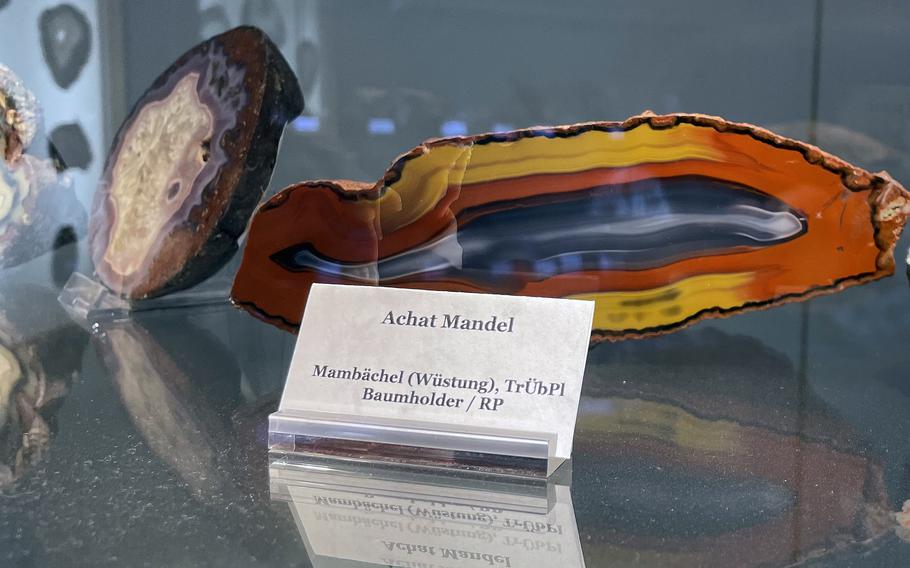
This agate rock in the shape of an almond shows its brightly colored, striped deposits. The formation, found in the abandoned settlement of Mambaechel, north of Baumholder, Germany, is one of many local gemstones and rock formations on display at the German Minerals Museum in Idar-Oberstein. (Jennifer H. Svan/Stars and Stripes)
Idar-Oberstein sparkles on even the gloomiest of German days, its precious stones bringing the area renown dating back to the discovery of the first mineral deposits more than 400 years ago.
Some of that history is on display at the German Museum of Minerals, along with colorful rocks and gems from the region and across the globe.
With four floors to explore inside a cozy old building, the museum was a great place to spend a few hours on a gray autumn day. It’s only 15 minutes from Baumholder, or a 45-minute drive from Kaiserslautern.
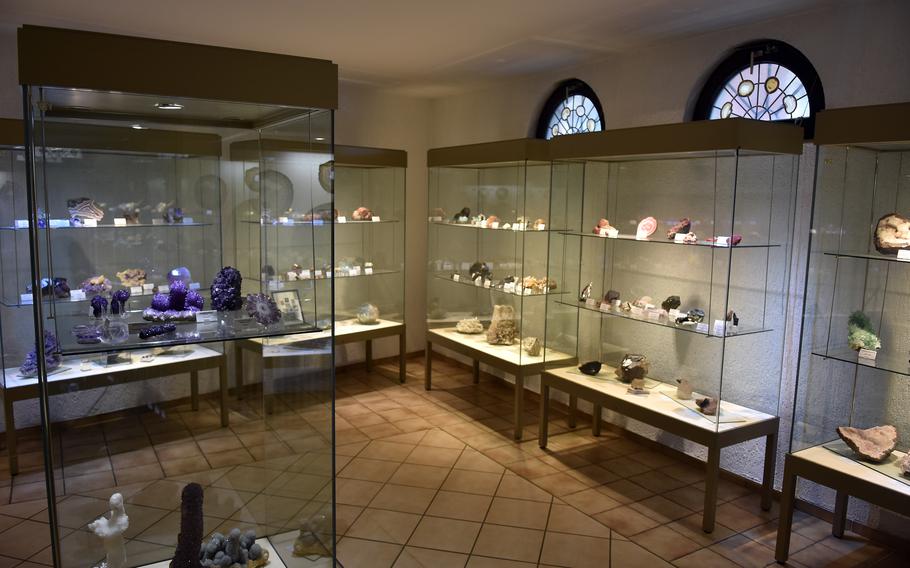
The German Minerals Museum in Idar-Oberstein has 24 rooms spread out over four floors, showcasing hundreds of colorful gems and rock formations from the region and across the world. (Jennifer H. Svan/Stars and Stripes)
The museum sits below the Felsenkirche, a church built into the rocky ledge of a cliff that towers above the Oberstein part of the town. The Nahe River historically divided the villages of Idar and Oberstein, which were first joined administratively in the 1930s.
One account from a well-known jeweler holds that the region’s first deposits of amethyst, agate and jasper were discovered during excavations for the church in the 14th century, giving rise to its gemstone industry. Mills along the river powered cutting and polishing machines.
When the hills started to dry up in the 1800s, miners and craftspeople emigrated to South America in search of fortune elsewhere. They found similar materials in Brazil and began shipping them to Idar-Oberstein, which kept gem cutting and jewelry production thriving.
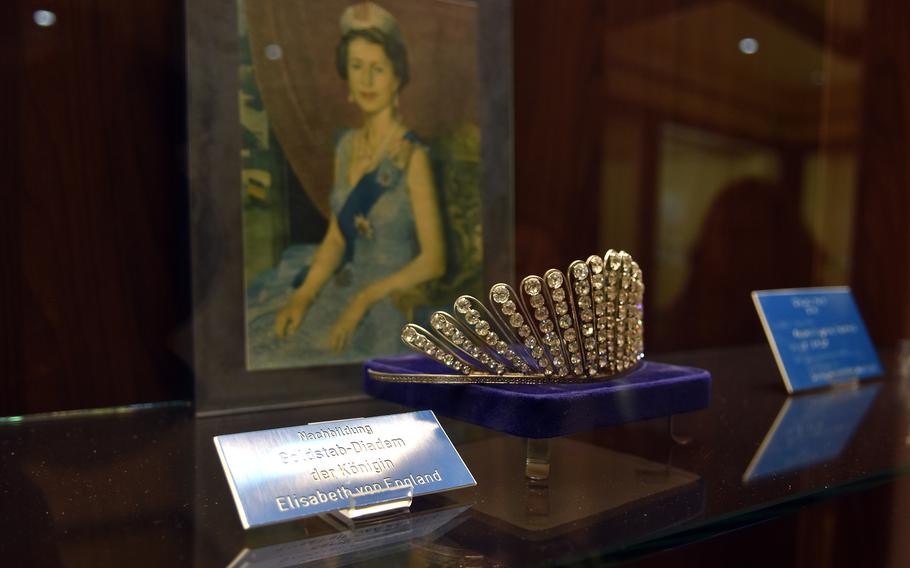
This replica crown of the late British Queen Elizabeth II is one of several examples of diamond jewelry reproductions worn by famous people on exhibit at the German Museum of Minerals in Idar-Oberstein. (Jennifer H. Svan/Stars and Stripes)
The museum’s jewelry collection includes dazzling necklaces, delicate hairpins and brooches and one of the smallest cameos in the world. One room holds some of the largest crystals ever imported into Europe from Brazil.
Another highlight was a dark room with luminescent gemstones. The lights turned off a few seconds after I entered, and the stones glowed like radioactive material under a UV light.
Though most signs at the museum are in German, it was easy to figure out the samples’ country of origin and the type of mineral, sometimes with a little help from an online translation tool.
The museum has specimens from all over, including a huge pyrite crystal from Peru, coral from Florida, a slab of copper from Michigan and, from Thailand, shiny black indochinites, pieces of natural glass formed by the impact of meteorites.
One display highlighted Hildegard von Bingen, the 12th-century German Benedictine nun who believed gemstones had healing powers. A laminated chart sold for 2 euros lists 34 stones and their purported properties.
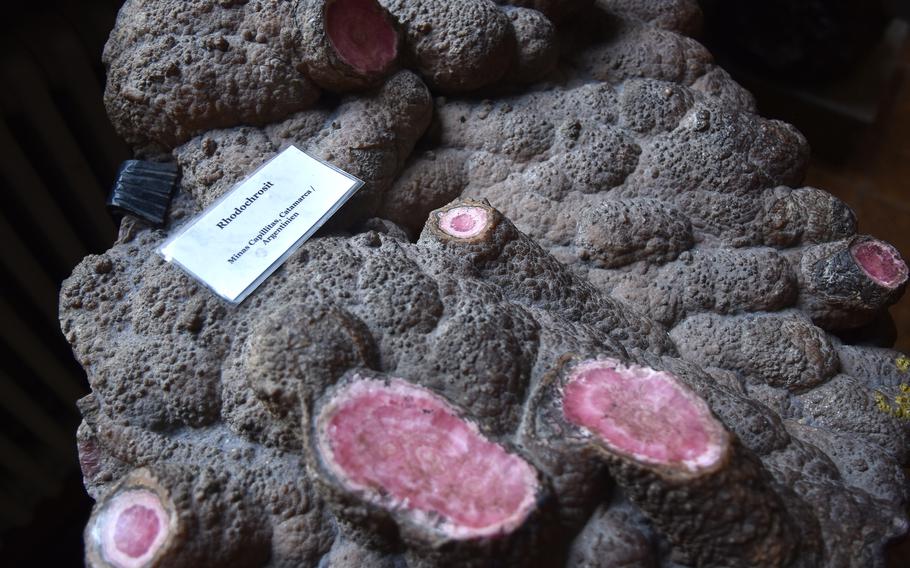
Sections of rhodochrosite, a light pink to bright red manganese carbonate mineral, can be seen exposed in a rock formation from Argentina, on display at the German Museum of Minerals in Idar-Oberstein. Rhodochrosite is Argentina’s national gemstone and is often used in jewelry. (Jennifer H. Svan/Stars and Stripes)
For instance, green jade is said to be good for digestion, while amber reputedly helps with allergies. Each stone elicited its healing powers in different ways, according to Hildegard.
She believed those with eye problems should moisten hyacinth with saliva and place it over the eyes, repeating frequently. As a side benefit, Hildegard also recommended hyacinth for demonic possession.
Another gemstone museum on the Idar side of the town has more than 10,000 exhibits and shows stones, diamonds, engravings and sculptures from 6,000 years of cutting and engraving.
For visitors who really want to get up close and personal with Idar-Oberstein’s mineral wealth, the Steinkaulenberg mine offers guided tours as well as a chance to dig for treasures of their own. Headsets with English translations are available.
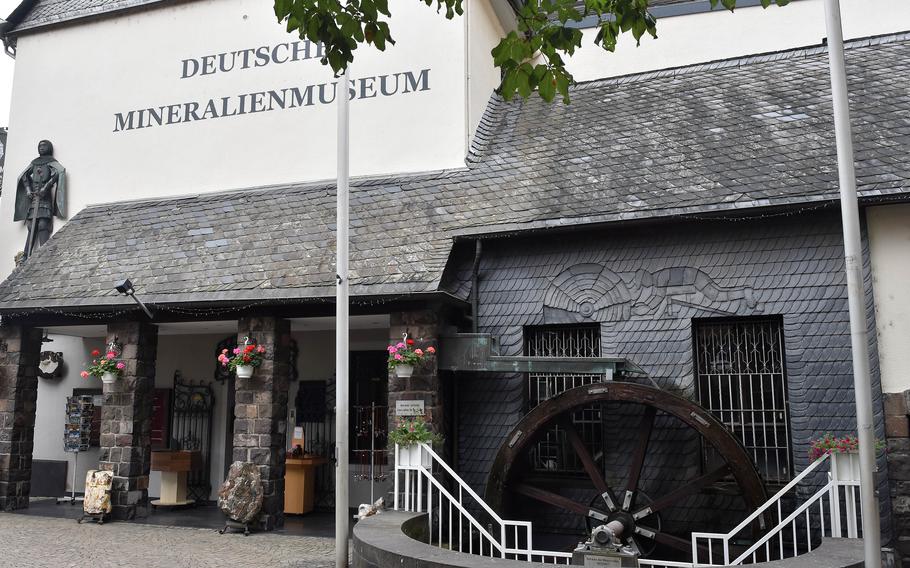
The German Museum of Minerals in Idar-Oberstein, Germany, showcases the colorful rocks and gems from the region and across the globe. The town lies along Germany’s 30-mile precious stones route and has a variety of jewelry and gem shops, along with several museums. (Jennifer H. Svan/Stars and Stripes)
On the QT
Address: German Museum of Minerals, Hauptstrasse 436, Idar-Oberstein, Germany; Steinkaulenberg mine, Im Stäbel, Idar-Oberstein, Germany
Hours: 10 a.m.-5 p.m. daily for both the museum and the mine. Tours of the mine run through Nov. 15, with the last tour of the day starting at 4 p.m.; gem digging sessions are at 10 a.m., 12:30 p.m. and 3 p.m. daily.
Food: Idar-Oberstein is known for spiessbraten, spit-roasted pork on a swinging grill. Das Spiessbratenhaus is in a half-timbered building a short walk from the mineral museum.
Cost: Museum admission is 8 euros for adults, 5 euros for seniors, 4.50 euros for students 15 and older and people with a disability, and 3 euros for students ages 6-14. A single adult ticket for the mine is 8 euros. Visitors in several categories, including military personnel, get a reduced rate of 6.50 euros. Free for kids under 6 if visiting as part of a family.
Information: https://deutsches-mineralienmuseum.de/, https://weiherschleife-steinkaulenbergwerk.de/home/the-steinkaulenberg-mine.html